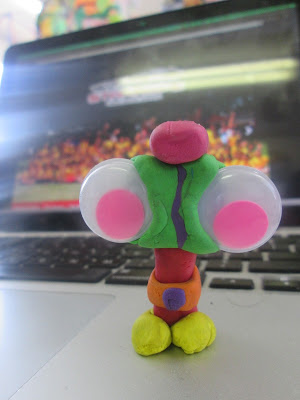https://www.youtube.com/watch?v=_3sNiiOlvjU
Junk - Art Sculpture
We live in
an increasingly complex world where issues of consumerism, pollution and
environmental responsibility are all opposing each other. We enjoy the comforts
of consumerism, yet we make a lot of waste with the packaging and disposal of
goods. Pollution effects our environment with dangers from chemicals, toxins
and manmade by-products from production techniques. How do we find a path to
satisfy both of these conflicting ideas/needs. Artists have always been at the
forefront of providing awareness on important issues and in helping to change
attitudes and shape policy.
Key Characteristics of Dada Art
Dada began in Zurich and became an international movement. Or non-movement, as it were.
Dada had only one rule: Never follow any known rules.
Dada was intended to provoke an emotional reaction from the viewer (typically shock or outrage). If its art failed to offend traditionalists, Dada writing -- particularly Tristan Tzara's manifestoes -- proved a fine, nose-thumbing Plan B.
Dada art is nonsensical to the point of whimsy. Almost all of the people who created it were ferociously serious, though.
Abstraction and Expressionism were the main influences on Dada, followed by Cubism and, to a lesser extent, Futurism.
There was no predominant medium in Dadaist art. All things from geometric tapestries to glass to plaster and wooden reliefs were fair game. It's worth noting, though, that assemblage, collage, photomontage and the use of ready made objects all gained wide acceptance due to their use in Dada art.
For something that supposedly meant nothing, Dada certainly created a lot of offshoots. In addition to spawning numerous literary journals, Dada influenced many concurrent trends in the visual arts (especially in the case of Constructivism). The best-known movement Dada was directly responsible for is Surrealism.
Dada self-destructed when it was in danger of becoming "acceptable".

Room 17 Alien design
Room 18 Stop Motion Clip
AIMS
excellence -
by aiming high and by persevering in the face of difficulties
innovation, inquiry, and curiosity - by
thinking critically, creatively, and reflectively
LEARNING INTENTIONS
Students will learn to
?€? Understand what Sculpture art is
?€? Discuss and investigate natural motion and the
physiology of the human body
?€? Use studies of the body in action poses and
emotional states
?€?
Imagine and create a character posed in an emotional state in sketches and the
construction
?€?
Create a wire armature figure using the correct steps and complete the
character using paper mache.
Discussion:
Define gesture as movement usually of the body or limbs that expresses
or emphasizes an idea, sentiment, or attitude or
the use of motions of the
limbs or body as a means of expression
- Look at examples of Giacometti?€?s work, as well as the work of other abstract
artist. How does abstraction contribute to the artist's ability to express an
idea?
- What are the ideas, moods and movements suggested in these works? What
do the works of these artists suggest to you?
- Look at photos or artwork of
individuals in motion, sports are a good subject for imagery.
- What is the
gesture represented? (figure leaning, foot stepping, etc.).
- How might artists enhance the mood or
idea with his technique or composition? Look at artists examples and discuss the settings for the
figures.
- Discuss the process used by Giacometti to build his sculpture.
Define armature as the base structure or ?€?bones?€? of the sculpture that hold it up. Look at the
steps he used from sketch to finished sculpture.
Project steps:
Warm up
exercises:
- Review the terms gesture and positive and negative space.
Class Room Numbers
Art Room
Room numbers background
Year 8 Mural background
1 Damien Hirst owns some of his work. As does Christina
Aguilera and Angelina Jolie.
2 He has artwork
commissioned by Bono.
3 Though
he initially drew freehand, he began stencilling seriously in 2001.
4 He
illustrated the opening credits to The Simpsons in 2010.
5 He’s conflicted about his success.
Banksy, a street artist whose identity remains unknown, is believed to
have been born in Bristol, England, around 1974. He rose to prominence for his
provocative stenciled pieces in the late 1990s. Banksy
is the subject of a 2010 documentary, Exit Through the Gift
Shop, which examines the relationship between commercial and street art.
Banksy began his career as a graffiti artist in the early 1990s, in
Bristol's graffiti gang DryBreadZ Crew. Although his early work was largely
freehand, Banksy used stencils on occasion. In the late '90s, he began using
stencils predominantly. His work became more widely recognized around Bristol
and in London, as his signature style developed.
Banksy's artwork is characterized by striking images, often combined with
slogans. His work often engages political themes, satirically critiquing war,
capitalism, hypocrisy and greed.
Year 8 Banksy , Compositions 2015 copyright!
Year 8 workbook page , copyright 2015
Year 8 workbook page , Banksy Study 2015
|
First we had to find
out what diversty meant. This is what
we came up with. This means we have to
have a goal and be working towards it.To be 'In the Waka' we all need to be a
team. We work towards the same goal
and all paddle in the same direction.
If someone falls out the waka, we need to stop and help them back in
again. We will reach our goal more
quickly in the Waka than if we were on our own.The problem is, a waka needs
some paddles. We are still thinking about
the key things we believe in. They
will become our guidelines - not rules but things we follow. We are beginning to think that we are all
teachers and learners in out class so AKO could be one. Give 100% effort might be another. Showing respect to people and things is
really important in Waka
Endeavour.
Room 17 Waka paddle design 2015
|







































